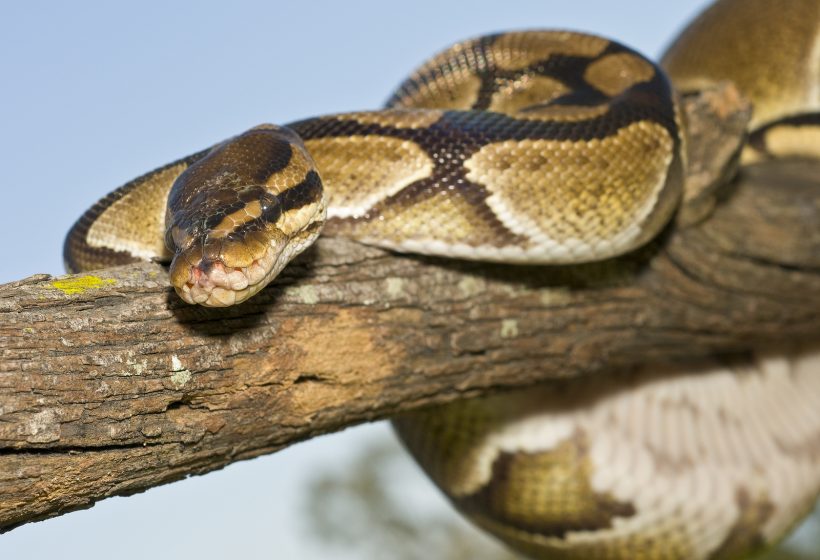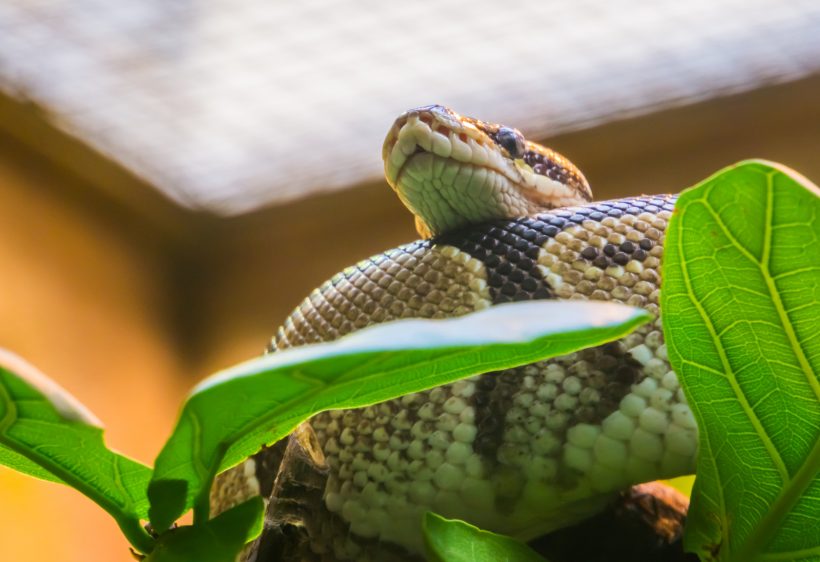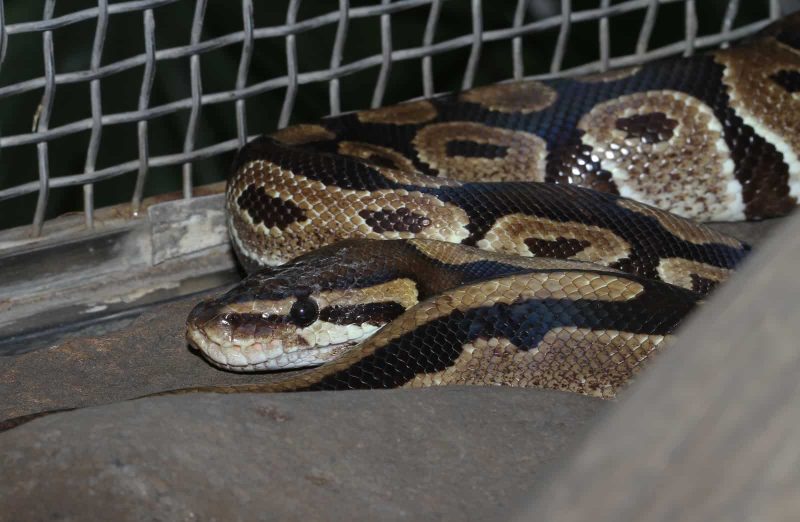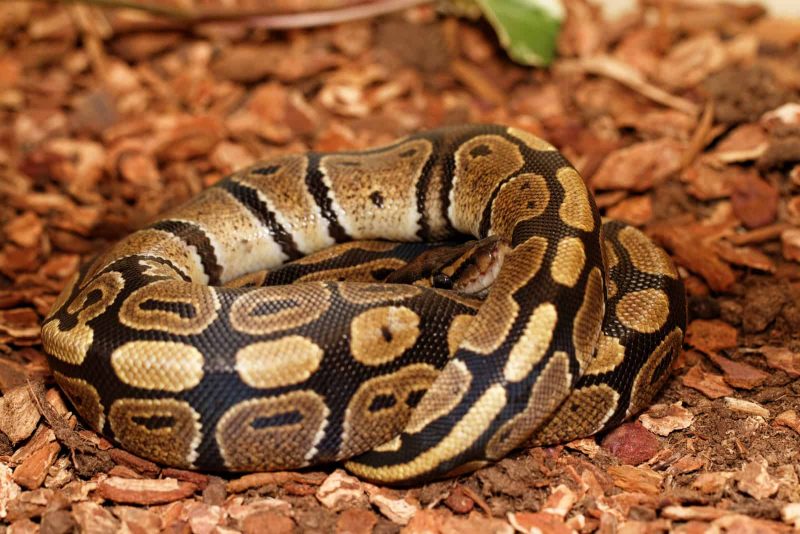When it comes to our ball python’s enclosure, we are trying to replicate their natural environment but reduce factors that cause sickness in the wild. Two of the key aspects of every environment are the temperature and humidity levels. If these are not kept under careful control, you may cause serious health issues to your python.
Reptiles are cold-blooded, therefore, cannot regulate their own body temperature, and so your python’s body is the same temperature as its surroundings. In order to allow your snake to maintain an optimum temperature, you must create a temperature gradient inside its vivarium, with a cold end and a hot end. Your ball python will then move between each end of its enclosure, depending on whether it feels too cold or too hot.
Our article on creating the perfect habitat for your ball python gives details on how to best set up your snake’s enclosure, along with a range of temperatures and humidity for your enclosure. Due to the significance of these factors, we have gone into far more detail in this article.
What Temperature Is Too High for a Ball Python?
When it comes to temperatures at the warm end of your python’s vivarium, it should be sitting at 90 degrees Fahrenheit, directly under your heat source reaching up to 92 degrees. Any temperature exceeding 92 degrees poses a serious risk to your snake. Never place your snake’s vivarium too close to the window or in direct sunlight as you will not be able to regulate the extra heat generated by the sun’s rays. This may result in overheating your snake’s enclosure and could cause the death of your beloved pet.
What Temperature Is Too Low for Ball Pythons During the Day and at Night?
During the day, the cool end of your python’s vivarium should be in the range of 80-81F. Depending on the temperature of the room you keep your python’s enclosure in, it is sometimes okay to switch off all of the enclosure’s heat sources at night. However, the temperature of the vivarium should not be allowed to drop below 77 degrees Fahrenheit. If the temperature does drop below this level, you will need to use a heat mat connected to a thermostat and leave it on 24/7. My recommendation is to make sure your vivarium reaches a warm side temperature of 86-87F and a cool side of 76-77F when night comes.
What Is the Best Heating Setup for My Python’s Vivarium?
As you know by now, we need to create a thermal gradient within our python’s vivarium and aim to replicate nature to the best of our ability. We, therefore, not only need to divide the hot and cold end but also day and night. Light sources should only be present during daylight hours, and as in nature, the temperature should drop at night. Heat sources are a potential burn risk for your python, so every effort needs to be taken to minimize this risk. Placing heat sources out of the direct reach of your snake is a must.
Some suitable heat sources for your python’s enclosure are heat lamps, ceramic heaters, heat tape, heat mats/pads, and radiant heat panels. These can be used in conjunction with each other or on their own, depending on the average temperature of the room you keep your snake’s enclosure in and so how much heat you need to provide. If you use heat sources that do not emit any light, then you will need to utilize an additional light source during the day, for example, a low-level UV bulb.
It is preferable to have heat coming from above as it does in nature, if you need to use a heat mat or something similar, it is advisable to place it on the back of your enclosure, not underneath. It is not natural for it to become warmer as you dig down, most snakes actually burrow to escape the heat of the day. Placing a heat mat under the substrate or enclosure also poses the risk of causing burns.
Heat sources should also be connected to a thermostat in order to properly regulate the temperature inside your ball python’s vivarium. We also recommend placing thermometers at both the warm and cool ends of the enclosure so you can manually monitor the temperature gradient.
What Is the Ideal Humidity for a Ball Python?
Ball pythons generally thrive at a relative humidity of between 60% and 70%. Your python enclosure’s humidity can be controlled with a suitable substrate, ventilation, water bowl size, and misting. Humidity can be measured using a hygrometer, and we advise that you check it daily to maintain your snake in good health.
You should also provide a moist hide inside your python enclosure. Fill the hide with sphagnum moss and keep it clean and damp. This hide provides an area of increased humidity to aid your snake during shedding.
Do Ball Pythons Need to Be Misted?
Misting is a good way to increase the humidity of your ball python’s enclosure. However, it is not the only way of maintaining good humidity levels, so it is not always necessary. The average humidity of a household room is between 30% and 50%. Therefore, we do need to utilize methods of increasing the humidity inside the snake’s enclosure.
Keep your python on a suitable substrate such as orchid bark, provide an adequate water bowl and good ventilation but not so much that all of the moisture escapes, and see what level of humidity is present in your vivarium. If this is not reaching around the required level, then misting is advisable but be sure not to mist too much.
How High Is Too High Humidity for Ball Pythons?
In general, you should never let your ball python’s vivarium exceed 70% humidity. Anything over this relative humidity can result in respiratory infections.
In addition, when humidity is too high, the substrate does not dry out properly, which increases the risk of scale rot. It is important to keep a close eye on the humidity level inside your python’s enclosure and adjust it accordingly.
If the humidity inside the enclosure is climbing too high, you may need to change the substrate, reduce the water bowl size or increase the ventilation. If your ball python appears to have scale rot or a respiratory infection, take a look at our article on ball python health for what to do.
Should I Increase the Humidity When My Ball Python Is Shedding?
Sometimes it may be necessary to increase the humidity of your ball python’s enclosure during shedding. If your python is having a bad shed or regularly struggles to shed its skin, then this is one potential solution for aiding with the process. The humidity can be increased up to but not exceeding 80% for a short period of time during the shedding process. It is extremely difficult to maintain high levels of humidity at the same time as providing adequate ventilation in captivity, which leads to an increased level of bacteria and fungi inside the enclosure. This should not be done regularly or for extended periods of time as it poses the risk of causing numerous infections. See our article on ball python shedding for other methods to assist your python with its shedding problems.
We understand that there is a lot of conflicting information on the internet and it can be hard to know what to do when it comes to your snake enclosure’s temperature and humidity. Hopefully, this article answers all of your questions in an easy-to-follow manner. If you have any further questions, we are always here to help, so please don’t hesitate to reach out in the comments below.
The article was written by Sam Davies and updated by Dr. Mohsin Iqbal.






11 Comments
Really like the suggestion of a moist hide box – should this be placed on the cool side or warm side of the enclosure?
Hi Daphne
To provide the best conditions for your reptile, it’s generally recommended to place the moist hide box on the warm side of the enclosure. This is indeed the best approach to maintaining a suitable level of humidity for your reptile.
Placing it on the cool side could result in it becoming just a cold, wet hide, which may not provide the desired conditions for your pet.
Can i use both a Ceramic heat emitter and Heat mat? im reading all these articles vs them. saying that the heat mat provides good hide heat, but not good air temperature. can i use a ceramic heat emitter on a dimmable switch to keep the air temp a 90 too?
Hi Paige,
The answer to your question depends on a few factors, such as the size and type of your tank, the ambient temperature of your room, and the temperature gradient you want to create for your snake.
You can use both a ceramic heat emitter (CHE) and a heat mat to heat your ball python’s enclosure, as long as you use a thermostat to control the temperature and prevent overheating.
Alternatively, using only a CHE with a good substrate and hides may be sufficient. Measure the temperature in different areas and aim for a gradient of 75-95°F (24-35°C), with a basking spot of 88-92°F (31-33°C), ambient temperature of 78-82°F (26-28°C), and a cool side of 75-80°F (24-27°C). Monitor humidity levels at 50-60%.
Hope this helps!
Another good article with excellent information!! Thank you!
I have another question. Should males and females be kept in separate rooms?
Hi David,
Keeping male and female reptiles in separate rooms is not necessary unless you’re trying to avoid accidental breeding or there’s aggressive behavior. The most important aspect is that each individual has its own enclosure, as cohabitation can often lead to stress, territorial disputes, and in some cases, injury or death.
However, during breeding season, some species might be able to detect the presence of the opposite sex even in separate enclosures, which could potentially cause changes in behavior. If you notice such changes, separating them more might be beneficial.
Always remember that understanding and catering to the specific needs of each individual species is crucial.
I have a couple questions. Is cocoa bricks good substrate, and should I pair them with that substrate in one of their enclosures, or should I put them in a long flat bin with paper?
Hi David,
Coco coir (cocoa bricks) is indeed an excellent substrate choice for ball pythons. It helps in maintaining the appropriate humidity level in the enclosure, which is crucial for these snakes.
As for the enclosure, ball pythons need a secure and adequately sized space. Both a suitably sized enclosure and a long, flat bin can work. The key factors are that it should have a temperature gradient, appropriate hides, and it should be secure to prevent escapes.
If you’re thinking about pairing or cohabitating two ball pythons, it’s generally not recommended. Even for breeding purposes, they should only be together briefly and under supervision. Cohabitation can lead to unnecessary stress, competition for resources, and in extreme cases, aggression.
For breeding or introducing two snakes, a neutral and temporary environment like a separate bin with a simple substrate like paper can be used for better monitoring.
Good luck with your ball pythons!
Hi,I’M new to this ,found your article very useful. Are there any plans of how a v.good vivarium should look? Many thanks JIMMY
Hi Jimmy!
I’m glad you found the article helpful. If you’re looking for more detailed plans on how a well-designed vivarium should look, I recommend checking out this link:
https://www.terrariumquest.com/vivarium/
This resource should provide you with valuable information and visual references to help you create a high-quality vivarium. Remember to consider the specific needs of your reptile species and adapt the plans accordingly. If you have any further questions or need more guidance, feel free to ask.
Enjoy setting up your vivarium!